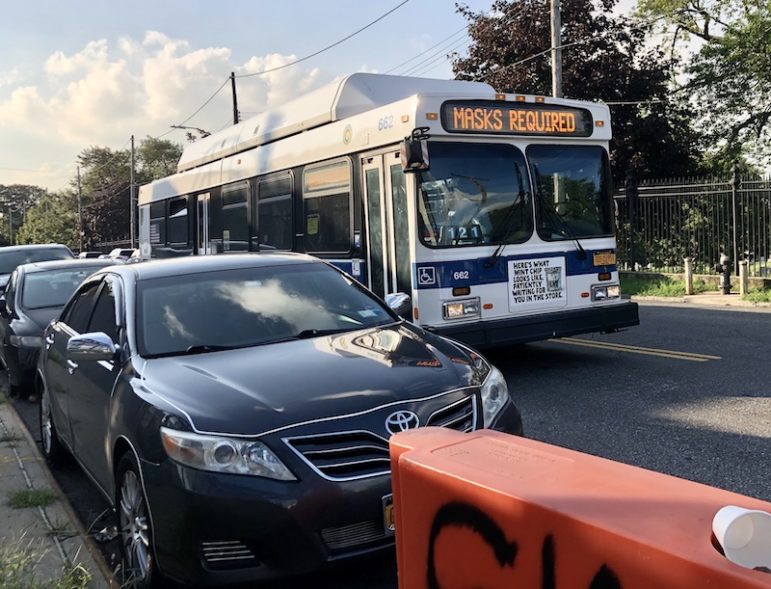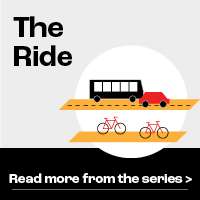Driving, cycling and bus usage have all rebounded somewhat since the first two months of the pandemic, but subway and commuter rail ridership remain low.

Jeanmarie Evelly
‘Researchers believe that ‘post-pandemic New Yorkers trust the above-ground, windows-open potential of the bus to a greater degree than the subway.As New York City continues to reopen from coronavirus lockdown measures, more and more residents are traversing the boroughs—and many are using cars to do so, transit advocates said Thursday, warning of a coming “carmageddon” that will bring increased congestion, pollution and crashes to city streets if the trend continues, especially with schools slated to reopen later this month.
Advocacy group Transportation Alternatives analyzed several transit metrics and found that driving, cycling and bus usage have all rebounded somewhat since the first two months of the pandemic, but subway and commuter rail ridership remain low. MTA bus ridership—which dropped by 78 percent during March and April—is now just 35 percent lower than it was during pre-COVID times. Subway ridership, however, was still down 74 percent in August.
“It appears that post-pandemic New Yorkers trust the above-ground, windows-open potential of the bus to a greater degree than the subway,” the group’s findings read.
Similarly, driving has been increasing: While the number of cars using the city’s bridge and tunnel crossings dropped steeply at the start of the pandemic, they’ve since climbed back up, having returned to pre-COVID levels in June. Overall traffic levels are down just nine percent from last year, the report notes.
Transportation Alternatives also analyzed Apple Maps data, which found a 27 percent uptick in New Yorkers searching for driving directions as the city reopened, while walking and public transit mapping requests decreased. The number of tickets issued to drivers by the city’s speed safety cameras went up 67 percent between February and August, prompting fears about increased traffic crashes.
The pandemic has, however, spurred more New Yorkers to take up cycling: The average number of bikes crossing the East River bridges on weekdays was up 23 percent in August compared to the year before, and Citi Bike ridership was also up last month.
Still, advocates say the city needs to act now to the curb the number of New Yorkers choosing cars over public transit. A number of transit groups who served on Mayor Bill de Blasio’s Surface Transportation Advisory Council—convened this spring to “provide guidance to shape the City’s response to the COVID-19 pandemic”—penned a letter to the mayor on Tuesday imploring him to implement more of the recommendations they published in June. Those included a call for the city to add 40 miles of emergency bus lanes before the end of summer and expand the city’s network of protected bike lanes.
On Thursday, City Comptroller Scott Stringer called for the city to encourage more students to bike to school this fall, since yellow school bus capacity is being reduced to comply with social distancing standards on buses—prompting concerns about even more increased car traffic from families driving their children to school.
Stringer is asking the city to construct 1.5 miles of protected bike lanes around 50 high school buildings in the next year, and to provide either free bicycles or Citi Bike memberships to low-income public high school students.
“Reimagining our streets is not a job we can postpone until after the pandemic,” Stringer said in a statement.










4 thoughts on “Fear of Traffic and Crashes as NYers Skip Subway for Cars and Bikes”
Hello, It seems to me that subway riders travelling on the #2 train from and to the Bronx are being discounted. The #2 train at 9:30am this morning going uptown was quite crowded in the middle sections of the train. I noticed this when I got off at 96th St. from the back of the train and walked the platform. And others that I have spoken to say that in the morning rush hour going downtown it is impossible to social distance on this train and on the #4 train coming from the Bronx going downtown. The riders are most probably essential workers and don’t have a choice (don’t have cars, and it’s too far to bike).
There are many reasons why more New Yorkers are buying vehicles. Covid-19 and fear of future pandemics have made many New Yorkers fearful of being packed into subways and buses. The drastic increases in street crime and subway crime under deBlasio have made private vehicles a safer travel option. Long intra-city trips are made for cars. The subways don’t go everywhere.
It’s true that most NYC households do not own a car. But the numbers are closer than most would think. If you exclude Manhattan then 52.13% of NYC households own a car.
NYC vehicle ownership went up by 106,339 between 2013 and 2018 (last year stats available). So-called ‘pedestrian-friendly’ Brooklyn saw an 8.94% increase (avg of 530 more cars per square mile) in car ownership during that time period.
Even deBlasio realizes that middle-class New Yorkers need cars. He has reduced alternate side parking regulation across the entire city down to one day per side maximum.
========================================
% of households with a vehicle | Borough
21.81% | Manhattan
44.45% | Brooklyn
62.78% | Queens
39.53% | Bronx
84.68% | SI
**** **** ****
44.97% | NYC TOTAL w/vehicle
52.13% | NYC w/vehicle EXCLUDING MANHATTAN – TOTAL
===================================================
NYC vehicle ownership stats – http://u.pc.cd/B9
ASP ‘reform’ extended to 9/19/2020 – https://www1.nyc.gov/html/dot/html/pr2020/pr20-036.shtml
Household is not the same as resident. You have a lot of households in NYC shared by multiple unrelated adults who do not have access to an automobile. A more common situation here than elsewhere. There’s a bit less than 2 million registered passenger non-commercial automobiles in a city with more than 8.3 million residents.
I do agree that anti-social behavior on public transit, COVID-19, and accessibility around the metro area drive increased automobile ownership.
The goal is to make public transportation better and make communities more walkable. More options within walking distance, safer streets to bike, priority to buses.
Traffic is already bad enough, we don’t need more drivers, we need a lot less.
Abolish all On-Street Parking. It should be illegal to park on the street. It’s hazardous, snarles traffic, is visually cluttered, takes up huge amounts of much needed space for other public uses, prevents NYC from having a modern trash collection system, and is a major taxpayer subsidy to a minority of unfair beneficiaries.
Abolish the zoning prohibition on parking garages in Residential Zones. It should be legal to operate a commercial parking garage in a residential district. Provide zoning incentives for automated parking garages. Do the same for Bicycle Parking, which should also be illegal to just toss on the street. Bike parking lots should be a retail storefront kind of thing. Like everywhere else in this world.
We need to get closer to the Japanese attitude of: do what you like, where you like, to the intensity level allowed, on private property, and NOT in the public way.
Abolish mandatory parking minimums for new developments.
Then watch the market figure it out: safer & cleaner streets with plenty of room for all traffic modalities, and it is much easier to achieve the elusive “road diet” street improvements. Those without a car no longer have to subsidize the cost of developing parking spaces into their rent, and will have more space in buildings for amenities. Those who choose to have a car, must pay the true and full personal cost of car ownership without public subsidy of free parking or their neighbors footing the bill in the rent as it costs way more to construct parking in new developments than the space rental proceeds cover. And likely, the total available number of parking spaces will increase due to removal of unwise zoning restrictions. Overall, transportation options would be cleaner and more heterogeneous.